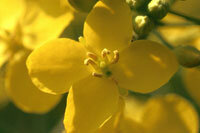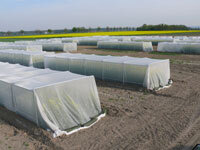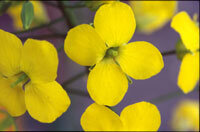How to breed a winning hybrid oilseed rape
Motherline

Hybrid varieties are produced by crossing a “female” plant, which is male sterile (ie, doesn´t produce pollen), with a fertile pollen-producing “male” plant, which restores 100 % male fertility (ie, pollen-producing ability) in the seed collected at harvest from the female. In the Ogura hybrid system DSV uses it is relatively easy to produce sterile female lines compared with the alternative MSL system some breeders use, because sterility can last for more than one generation. One of the keys for DSV in its breeding programme is to develop pools of different genetic types of mother lines. It is also important to consider how well the male and female lines combine with each other. For example, if the female flowers earlier than the male, that makes things difficult, as it won´t be pollinated as efficiently and seed yield will be reduced.
Fatherline

The male pollinator has to restore fertility in the seed collected from the female at harvest. But in the Ogura system, unlike the MSL system, not every pollen-producing oilseed rape plant can “restore” male fertility. That´s because the male sterility gene originally came from radish plants, and was found in the cytoplasm DNA, rather than nuclear DNA. It means the male plant has to be able to switch male sterility off in the cytoplasm, something not every variety can do. Male restorers don’t necessarily have to be of the highest agricultural value. In fact they are quite often varieties you wouldn´t want to grow commercially. They are chosen because the genetics work well together.
Genetic separation of the male and female lines is crucial to the success of hybrids. If you can develop pools of the material genetically separate enough from each other, then you get heterosis, which gives greater hybrid vigour and yields, when you combine them.
Small-scale seed production

Once the male and female lines have been identified, breeders use small-scale seed production in tents to produce greater quantities of seed of those lines, and to produce small quantities of F1 hybrid seed for testing. Despite only certain male lines being able to restore the fertility, foreign pollen can easily pollinate the mother line. But seed produced from plants pollinated by foreign pollen won´t be the genetic variety the breeder is trying to produce. It may also still be male sterile. To prevent unwanted pollination the breeder uses small tents made of a thin gauze to create a pollen-proof barrier for the plants. We also introduce bumble bees and flies into the tent to help the pollination process because the tents also restrict wind flow.
Selfing bags

Hybrid oilseed rape breeding all starts with the breeder´s eyes picking out individual plants for the attributes he is looking for. Identified plants are then self-pollinated to ensure the seed is a genetic replica of that plant by putting a “selfing” bag over the plant before it flowers to prevent it being pollinated by any other oilseed rape plant. Seed from those plants is usually used to produce father lines. Mother lines can also be produced using selfing bags, but need to be pollinated by a “maintainer” line, which means the seed is malesterile.
Farm-scale seed production

Typically seed producers use a 12-coulter drill to plant three rows of the father line and nine rows of the mother line. Drilling back-to-back gives a block of six rows of father line either side of 18 rows of mother.
Usually the father line flowers a bit before or at the same time as the mother. The seed grower extends the male flowering period by cutting it at an angle during stem extension – plants not mown flower earlier, while the cut plants have to grow hard again and flower three weeks later. It increases seed yields, because of availability of pollen during the whole flowering time of the mother line. The male line is then mown out, as it will produce seed that isn´t the desired F1 hybrid. Effectively, that means only 60-70 % of the field is harvested for seed production, which, along with the increased technicalities in producing the mother and father lines, increases the expense of hybrid production.
Hybrid - Your advantage

Typically, hybrids grow 10-15 % taller than conventional inbred varieties breeders are trying to combine materials that reduce that height, and increase standing power – and the genetics are getting better. Aim to establish 30-35 plants/sq m in the spring by sowing about 50 seeds/sq m. If you have above that the plant has capacity to produce more pods, but you push yield of single plants down because of competition. Too few plants and the stems grow like tree trunks and it becomes difficult to combine. You can also get more pod shattering because of maturity delays in side branches.



